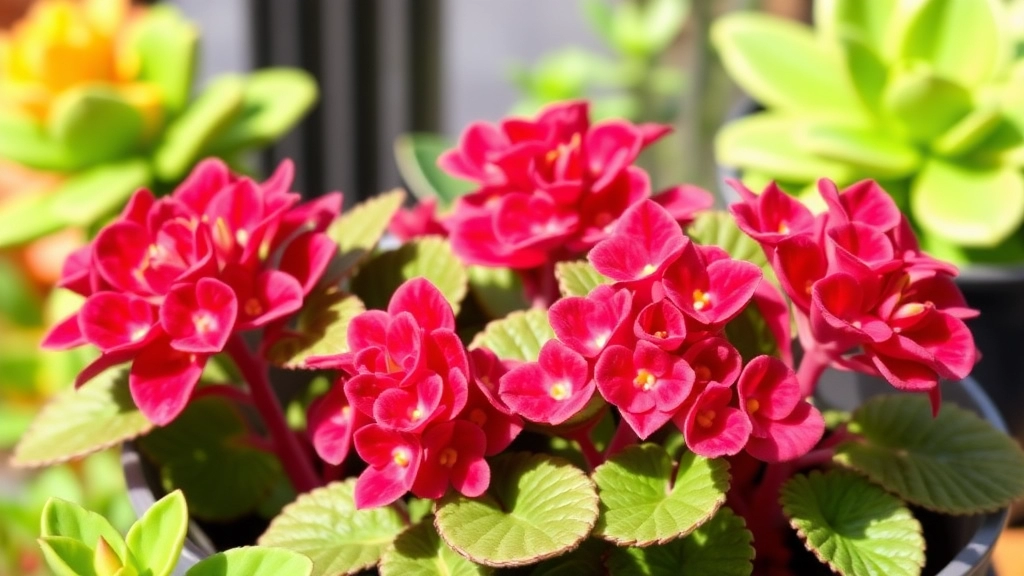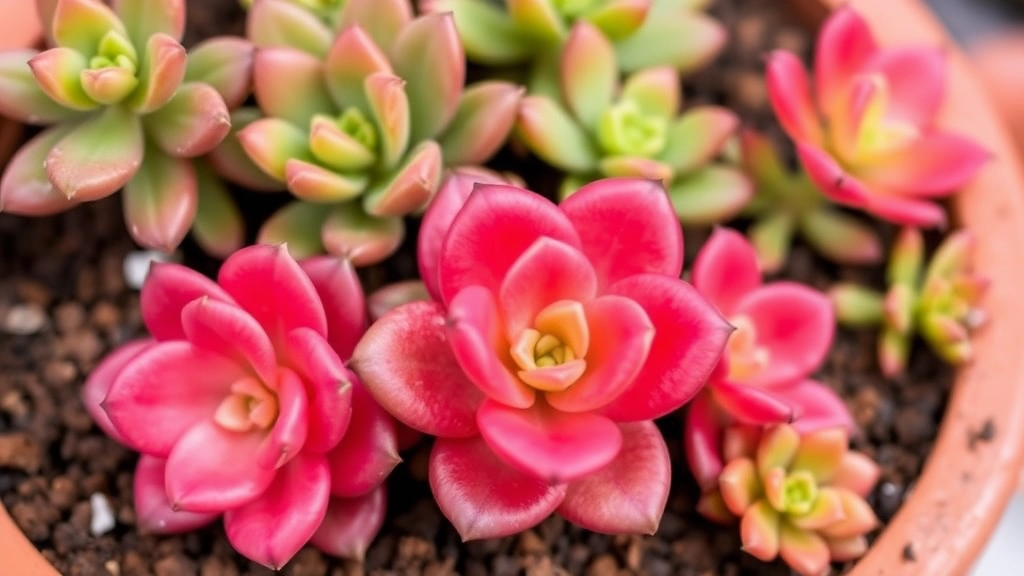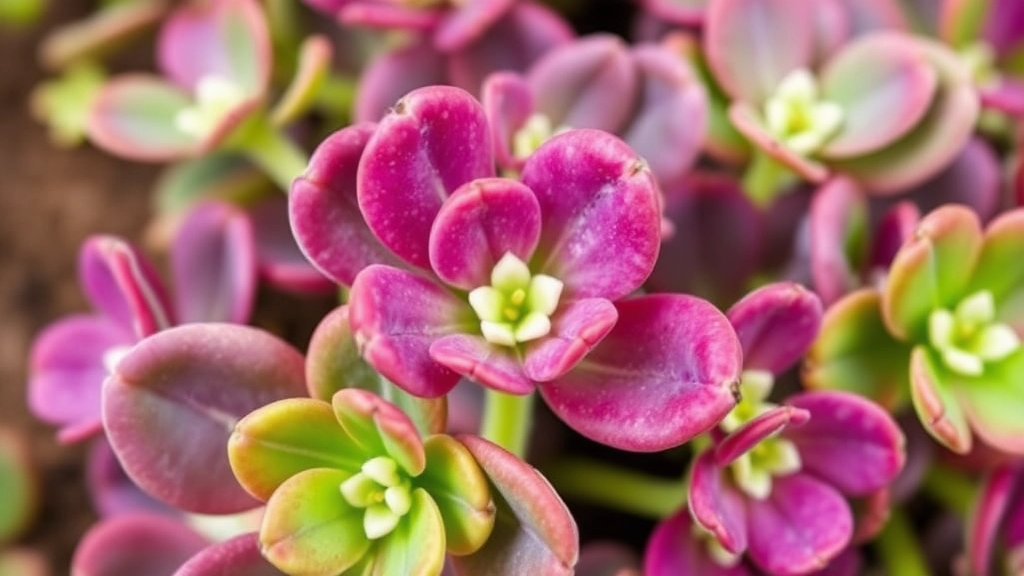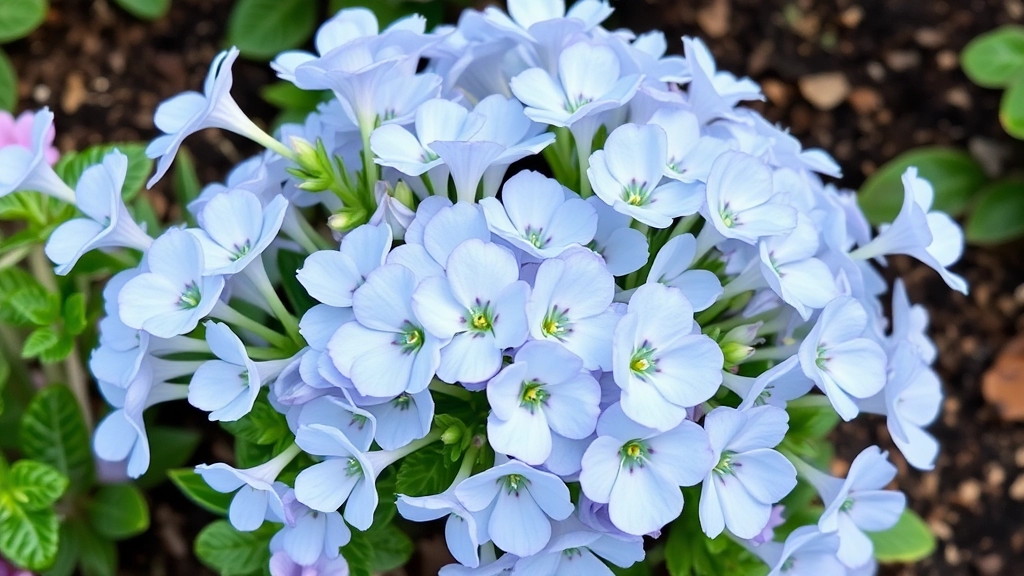Light Blue Kalanchoe
When it comes to the captivating world of succulents, the Light Blue Kalanchoe stands out with its unique blue-tinted foliage. This specific variety, often referred to as Kalanchoe fedtschenkoi or Kalanchoe marnieriana, showcases bluish-green leaves that add a touch of elegance to any plant collection. If you’re curious about how to care for this stunning plant, you’re in the right place.
Care Guidelines
Understanding the ideal conditions for your Light Blue Kalanchoe is key to keeping it healthy and vibrant. These succulents thrive in bright, indirect light and prefer moderate temperatures. Proper watering is essential; overwatering can lead to root rot, so it’s best to let the soil dry out between waterings. Additionally, using well-draining soil and the right pot can make a significant difference in the plant’s health.
Simple Tips for Success
- Provide bright, indirect light
- Maintain moderate temperatures
- Water only when the soil is dry
- Use well-draining soil
- Select an appropriate pot
Follow these simple guidelines, and your Light Blue Kalanchoe will flourish, adding a unique charm to your indoor or outdoor space.
Varieties of Kalanchoe with Blue-Tinted Leaves
Have you ever wondered about the stunning varieties of Kalanchoe that boast blue-tinted leaves? These unique succulents not only captivate with their colour but also add a distinctive flair to any plant collection.
Among the most popular varieties, you’ll find:
- Kalanchoe luciae: Known as the paddle plant, its large, flat leaves display a striking blue-grey hue, particularly when exposed to bright light. For more detailed care tips, check out our Kalanchoe Paddle Plant Flower Care Guide.
- Kalanchoe thyrsiflora: Often referred to as the flapjack plant, this variety features fleshy, rounded leaves that take on a lovely blue tint, especially in cooler temperatures.
- Kalanchoe beharensis: With its thick, textured leaves, this variety showcases a subtle blue-green shade, offering a more muted yet appealing aesthetic. Learn more in our Guide to Growing and Caring for Kalanchoe Beharensis.
- Kalanchoe tomentosa: Also known as the panda plant, its fuzzy, blue-tinged leaves have a unique silvery appearance, making it a delightful addition to any collection.
These varieties not only stand out visually but also thrive in various conditions, making them a favourite among succulent enthusiasts.
Ideal Light and Temperature Conditions for Kalanchoe

So, you’ve got your eye on those stunning blue-tinted Kalanchoe leaves, but are you sure you know how to keep them thriving?
Light Requirements
Kalanchoe loves the sun, and trust me, it’s a big fan of bright, indirect light. Here’s what you need to keep in mind:
- Direct Sunlight: Aim for about 6 hours of bright, indirect sunlight daily. Too much direct sun can scorch those lovely leaves.
- Indoor Placement: If you’re keeping them indoors, a south or west-facing window is ideal. Just be cautious of the midday sun.
- Signs of Insufficient Light: If your Kalanchoe starts stretching or its leaves lose colour, it’s a cry for more light.
Temperature Needs
These plants are pretty chill, but they do have their preferences when it comes to temperature:
- Ideal Range: Keep them in a cozy spot between 18°C to 24°C (65°F to 75°F). They’re not fans of the cold.
- Avoid Drafts: Sudden temperature changes can stress them out. Keep them away from drafty windows or air conditioning vents.
- Winter Care: If you live in a cooler climate, make sure to bring them indoors when temperatures drop below 10°C (50°F).
Watering Needs for Blue-Leaved Kalanchoe Varieties
When it comes to caring for blue-leaved Kalanchoe varieties, one of the most common concerns is understanding their watering needs. Overwatering is a frequent issue that can lead to root rot, while underwatering can cause the plant to wilt. So, how do you strike the right balance?
Key Watering Guidelines:
- Frequency: Water your Kalanchoe when the top inch of soil feels dry to the touch. This typically means watering every 2-3 weeks, but it can vary based on your environment.
- Technique: Use the soak-and-dry method. Water thoroughly until it drains from the bottom, then allow the soil to dry out completely before the next watering.
- Seasonal Adjustments: During the growing season (spring and summer), increase watering frequency. In the dormant months (autumn and winter), reduce watering to prevent excess moisture.
- Signs of Stress: Watch for signs of overwatering, such as yellowing leaves or mushy stems. Conversely, if leaves are shrivelling or dropping, it may be a sign of underwatering.
By following these guidelines, you can help ensure your blue-leaved Kalanchoe thrives. For more detailed care tips, check out our complete guide to Kalanchoe plant care and learn about the best soil for Kalanchoe Blossfeldiana.
Soil and Potting Requirements for Kalanchoe Succulents

As we explore the essentials for nurturing blue-leaved Kalanchoe, the importance of proper soil and potting cannot be overstated.
Choosing the Right Soil
Kalanchoe succulents thrive in well-draining soil, which is crucial for preventing root rot. Here are some key points to consider:
- Cactus Mix: A commercial cactus mix is often ideal, providing the drainage Kalanchoe needs.
- DIY Mix: If you prefer to create your own, combine:
- 50% potting soil
- 25% sand
- 25% perlite or pumice
This blend ensures that water drains quickly while still retaining some moisture.
Potting Considerations
Selecting the right pot is just as important as the soil. Here’s what to keep in mind:
- Drainage Holes: Always choose pots with drainage holes to allow excess water to escape.
- Size Matters: Opt for a pot that is slightly larger than the root ball of your Kalanchoe. This gives it room to grow without retaining too much moisture.
- Material: Terracotta pots are a fantastic choice as they allow for evaporation, helping to keep the soil dry.
Repotting Tips
Repotting your Kalanchoe can rejuvenate its growth. Here’s when and how to do it:
- When to Repot: Every 1-2 years, or when you notice roots growing out of the drainage holes.
- How to Repot:
- Gently remove the plant from its current pot.
- Shake off excess soil from the roots.
- Place it in the new pot with fresh soil, ensuring it sits at the same depth as before.
By following these soil and potting guidelines, you’ll set your blue-leaved Kalanchoe up for success.
Fertilizing Kalanchoe: Best Practices for Healthier Blooms
When it comes to ensuring your Kalanchoe thrives, fertilizing is a crucial step that many plant owners often overlook. You might be wondering, “How do I effectively fertilize my blue-tinted Kalanchoe to encourage vibrant blooms?”
Understanding Fertilizer Needs
Kalanchoe, particularly those with blue-tinted leaves, benefit from a balanced fertiliser that supports their growth and flowering. Here are some key points to consider:
- Type of Fertilizer: A balanced, water-soluble fertiliser with an N-P-K ratio of 10-10-10 or 20-20-20 is ideal.
- Frequency: Fertilize every four to six weeks during the growing season (spring and summer).
- Dilution: Always dilute the fertiliser to half the recommended strength to avoid burning the roots.
- Timing: Apply fertiliser when the soil is slightly moist, which helps prevent root damage.
Signs Your Kalanchoe Needs Fertilizing
Keep an eye out for these indicators:
- Pale Leaves: If the leaves lose their vibrant colour, it may be time to fertilize.
- Stunted Growth: If growth appears slow or stagnant, your plant might be nutrient-deficient.
- Reduced Flowering: Fewer blooms can signal a need for more nutrients.
Best Practices for Application
To ensure your Kalanchoe gets the most out of fertilisation:
- Use a Spray Bottle: For even distribution, consider using a spray bottle to mist the diluted fertiliser onto the leaves.
- Avoid Over-Fertilising: Too much fertiliser can lead to salt buildup, which can harm your plant.
- Flush the Soil: Every few months, flush the soil with water to remove excess salts.
For more tips on growing and caring for your Kalanchoe, check out our ultimate guide to growing and caring for succulent plant Kalanchoe. If you notice the leaves turning soft, you might find our article on causes and solutions for soft Kalanchoe leaves helpful.
Common Pests and Issues with Blue-Leaved Kalanchoe

So, you’ve got your stunning blue-tinted Kalanchoe, and it’s thriving—until it’s not.
What’s going on?
Pests and issues can sneak up on you, but don’t worry; I’ve got your back.
Common Pests
- Mealybugs
These little white cottony pests love to hide in the leaf joints.
They suck the sap, leading to yellowing leaves. - Spider Mites
Tiny and often unnoticed, they can cause webbing on your plant.
Look for speckled leaves as a sign of their presence. - Aphids
These tiny green or black bugs can also sap the life out of your Kalanchoe.
They tend to congregate on new growth.
Signs of Trouble
- Yellowing Leaves: Could be a sign of pests or overwatering.
- Drooping: Might mean your plant is stressed, possibly from pests.
- Webbing: If you see this, it’s time to act fast against spider mites.
Solutions
- Manual Removal: For mealybugs, use a cotton swab dipped in alcohol.
- Insecticidal Soap: Spray it on affected areas. It’s a gentle yet effective way to tackle pests.
- Neem Oil: This natural remedy works wonders against a variety of pests.
Are you eager to expand your collection of light blue Kalanchoe?
Propagation is a rewarding process that allows you to multiply your plants without breaking the bank.
1. Leaf Cuttings
– Select Healthy Leaves: Choose plump, healthy leaves from your parent plant.
– Cut and Callus: Cut the leaf at the base and let it sit for a few days to form a callus over the cut surface.
– Plant: Place the leaf on well-draining soil, ensuring the cut end is in contact with the soil.
– Water Sparingly: Mist the soil lightly, but avoid overwatering.
2. Stem Cuttings
– Choose a Stem: Look for a healthy stem with several leaves.
– Cut and Dry: Cut the stem just below a leaf node and let it dry for a day or two.
– Plant: Insert the cut end into well-draining soil, burying it about an inch deep.
– Water: Water lightly after planting, then allow the soil to dry out between waterings.
3. Offsets
– Identify Offsets: Some Kalanchoe varieties produce offsets or “pups” around the base.
– Remove Carefully: Gently twist or cut the offset away from the parent plant.
– Replant: Place the offset in its own pot with suitable soil.
– Water: Water lightly and place it in indirect sunlight.
4. Seed Propagation
– Collect Seeds: If your Kalanchoe flowers, collect seeds after they mature.
– Sow: Scatter seeds on the surface of moist soil.
– Cover Lightly: Lightly cover with soil and mist to keep it damp.
– Germination: Place in a warm, bright location until seeds germinate.
Tips for Successful Propagation
– Humidity: Maintain a humid environment by covering cuttings with a plastic bag until roots develop.
– Temperature: Keep the temperature warm, ideally between 20-25°C (68-77°F).
– Patience: Propagation can take time, so be patient and monitor your cuttings regularly.
For more detailed guidance, check out our [complete care guide for pink Kalanchoe plant](https://planthq.org/complete-care-guide-for-pink-kalanchoe-plant/) and discover the [health benefits of Kalanchoe Pinnata extract](https://planthq.org/health-benefits-of-kalanchoe-pinnata-extract/).
Frequently Asked Questions (FAQs) about Light Blue Kalanchoe
What kind of light does a Light Blue Kalanchoe need?
Kalanchoe thrives in bright, indirect light. Aim for about 6 hours of such light daily. If kept indoors, a south or west-facing window is ideal.
Can Kalanchoe tolerate direct sunlight?
While Kalanchoe loves bright light, too much direct sunlight can scorch its leaves. It’s best to provide bright, indirect light.
What is the ideal temperature range for Kalanchoe?
Kalanchoe prefers temperatures between 18°C to 24°C (65°F to 75°F). Avoid exposing it to temperatures below 10°C (50°F) and keep it away from drafts.
What type of soil is best for Kalanchoe?
Kalanchoe succulents thrive in well-draining soil. A commercial cactus mix is ideal, or you can create your own mix with 50% potting soil, 25% sand, and 25% perlite or pumice.
How often should I repot my Kalanchoe?
Repot your Kalanchoe every 1-2 years or when you notice roots growing out of the drainage holes. This helps rejuvenate its growth.
What are common pests that affect Kalanchoe?
Common pests include mealybugs, spider mites, and aphids. These pests can cause yellowing leaves, drooping, and webbing on your plant.
How can I treat pest infestations on my Kalanchoe?
For mealybugs, use a cotton swab dipped in alcohol. Insecticidal soap and neem oil are also effective treatments for a variety of pests.
Why are my Kalanchoe’s leaves turning yellow?
Yellowing leaves can be a sign of pests or overwatering. Check for pests and adjust your watering schedule accordingly.
What should I do if my Kalanchoe is drooping?
Drooping can indicate stress, possibly from pests or improper care. Inspect the plant for pests and ensure it is receiving the right amount of light and water.
What type of pot is best for Kalanchoe?
Choose a pot with drainage holes to allow excess water to escape. Terracotta pots are a good choice as they help with evaporation, keeping the soil dry.
References
-
Kalanchoe Plant Care – Gardening Know How
-
How to Grow Kalanchoe Plants Indoors – The Spruce
-
Kalanchoe: How to Grow and Care for Kalanchoe Plants – The Old Farmer’s Almanac
